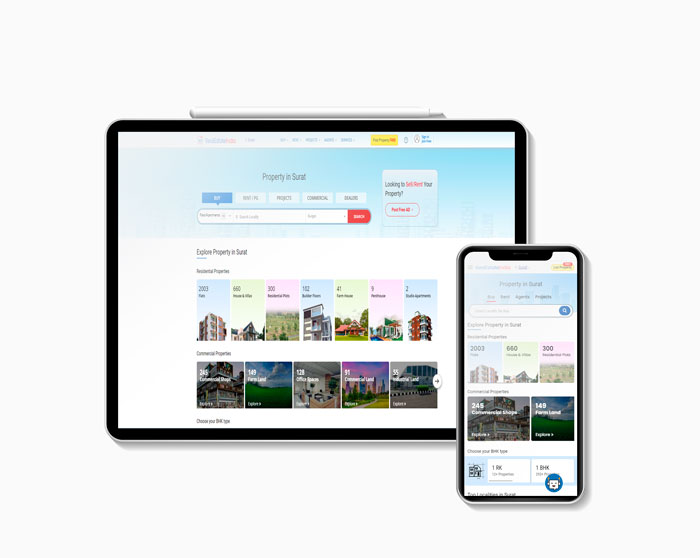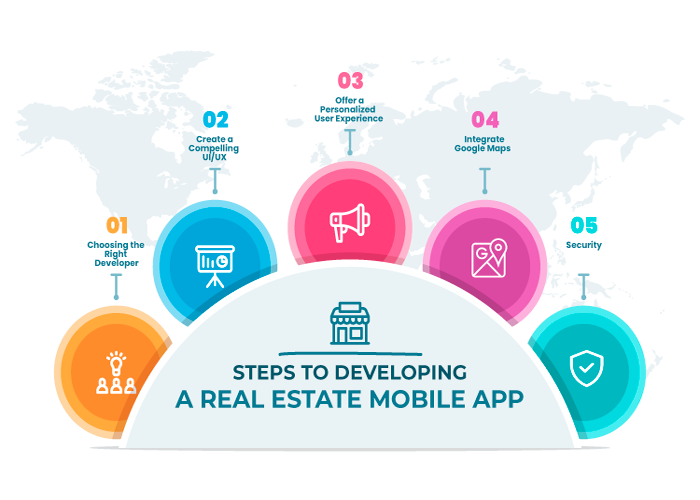September 09, 2022
By: PhoenixBizz Staff Writer
PhoenixBizz is a division of Sofvue, LLC
Printed with permission of Data Titan and Sofvue LLC
With people looking for properties online, the demand for real estate listing apps is increasing every day. According to the National Association of Realtors, 97% of home buyers use the internet to search for homes. Younger millennials conducted 65 percent of their mobile search on mobile devices, while 75% of Baby Boomers used desktops and laptops to conduct searches.
With so much money at stake, it's no wonder that real estate companies are interested in creating apps to help facilitate the buying and selling process. The problem is that most real estate companies don't know where to start when it comes to building a real estate app.

Therefore, it is vital to know what it takes to build a real estate property listing mobile app, including its features, steps, and costs. To make things easier, we've prepared this “starter” guide to help you understand some of the important steps in the process!
Key Features of a Real Estate Mobile App
While the exact features may vary based on your business’s unique requirements, these are the most common.
Customer Facing Registration and User Interface
#1. Sign Up
The user will enter their email address, username, and password to sign up on your app. This will help you understand who your customers are and personalize your offers. To improve the user experience, you can also offer social sign-up (Google and Facebook) options so they can sign up with one click.
#2. Dashboard
Also known as the homepage, a dashboard will show users the top locations and allow them to search for a property address, project name or by location (like entering Los Angeles or Phoenix). This is also where users should be able to see past searches, profile selections, saved property searches, interaction with owners, and more.
#3. Property Search Feature
The single and most important reason someone will visit your mobile app is to search and view available listings for sale. Therefore, it’s important to ensure that it’s easy to use and allows people to find available inventory quickly.
When designing this section of your app, you should consider the following:
➤ Location: The user should be able to search for homes by location easily (e.g., “Laguna Beach, California”). You can also include additional features like “within 1 mile” or “within 2 miles.” This will allow users to narrow down their options based on where they want their property located within the area or city they are searching.
➤ Price range: The user should be able to quickly filter through different price ranges when looking at homes on your platform.
➤ The number of bedrooms/baths: This is another way for users to filter the found properties list.
➤ Square footage: Many people look at square footage before making an offer on a home because it helps them determine if it will meet their needs.
#4. Interactive Map Features
Map-based apps are a great way to provide property details. But do your best not to overload your map with too many unnecessary features, otherwise, you have two problems. First, you will overload your map detail. Second, you will increase the download time to the phone, and consumers won’t wait more than one or two seconds for content. If it takes more than two seconds, you’ll lose the prospect. You should also include at least one way for the user to zoom in or out on the map so they can see everything at once (or as little as possible). Additionally, include all necessary information when displaying each property on the map. For example, any pop-up should include some particulars associated with the property. When clicking the pop-up, the screen should refresh and display the agent’s contact details so the consumer viewing the property knows who to call.
#5. In-App Messaging
Running a successful brokerage or property management company requires, above all else, making the phone ring. It’s about the first contact, whether by phone, text, message or shout-out. If searching for properties is the most important reason a visitor visits your app, in-app messaging is the most important reason that a mobile app should even commence. The in-app messaging services allows buyers and sellers to connect with you (mobile-to-mobile) over the app without sharing their personal contact information. They can even connect with an agent in your brokerage office with the click of a button.
For Property Owners and Agents
◾Sign Up
Allow property owners and in-office real estate agents the ability to create an account, so they can list properties on your app. So, if your brokerage company has 10 agents, each could be given access and permission to upload listings directly through your application system that then display across all mobile screens.
◾Profile Management
Once you've added all the agents in your brokerage, you'll want to create a profile page for each agent. These controls might be “company managed” meaning that you have an administrator who manages the agents, or “User managed”, meaning that your agents could upload their own properties directly into the system. With these two options in mind, consider these additional features:
✅ Ability for agents to upload their profile pictures and contact information
✅ A profile of their experience and qualifications, including how many years they’ve been in business, how many properties they've sold and what makes them uniquely qualified to assist buyers and sellers needs
✅ Links to any online profiles or reviews (e.g.: Google My Business)
You may also want to include testimonials from previous clients who were pleased with their experience working with your brokerage office or the agents at your company.
◾On-Demand Service
The app must provide on-demand services such as preparing a CMA or BPO on a home, along with other related services. This feature should also be available for real estate agents and owners to provide the right price for the listed properties to potential customers.
◾Video Tour Option
Now that download speeds are fast virtually everywhere, people want to visit homes -- without visiting homes. A video tour option is a must-have for property owners so they can view videos of homes they are interested in with a single click. This allows homeowners to showcase a home’s best features and amenities, from gourmet kitchens and luxurious master suites to beautiful outdoor spaces, views, swimming pools or tennis courts. Video tours should be short and sweet, no more than two minutes. Oh, and it’s not necessary to tell people watching the video that you are “in the kitchen” or “on the deck”. They know where you are.
Note: Your property listing app development company will assist you in choosing the right features for your app and ensure it meets your requirements!
Steps to Developing a Real Estate Mobile App
Now that you know what features to add to your real estate property app, let’s look at the key steps to developing the solution.

Step#1 Choosing the Right Developer
In order to understand how the app should look and function, it’s important to identify which company is right for the project. This helps you see what other real estate apps do well, what they don't, and what they're missing.
When analyzing a developer’s past app projects, look for:
✅ The number of downloads per day
✅ What kind of content do they have on the app (pictures, videos, text)?
✅ How often do they update the information or launch new features?
✅ Is the user interface easy to navigate… is it intuitive?
This research will also help you develop a marketing strategy for your new app and identify potential problems that might arise during your app’s launch.
Step#2 Create a Compelling UI/UX
Today, UI/UX, or how people interact with your mobile app, is everything. That said, be sure to consider the following regarding the people using the app.
✅ What do the users care about?
✅ What are their needs and wants when viewing property listings?
✅ How can you make their lives easier by providing them with information on demand at any time and in a format that's easy to understand and navigate?
Remember, the best apps give users what they need at a glance while also being easy enough for anyone to use without any training or manuals. Simplicity is key when designing a mobile application because space on mobile devices is limited compared to desktop applications.
Step#3 Offer a Personalized User Experience
Offering a personalized experience has become more important than ever. By using data to customize searches based on their preferences and past behavior, you'll be able to offer home buyers better search results that are relevant and easy to understand, along with easy contact information where they can get more information.
This is especially true regarding real estate apps that rely heavily on location-based technology. Allowing consumers and home buyers the ability to search for homes based on proximity, price range, and other factors, such as the number of bedrooms or square footage, gives them what they need, and at exactly the moment they need it.
Step#4 Integrate Google Maps
Once you have completed the initial setup, integrate Google Maps into your app. Your app development company will be able to help you with the Google Maps API integration and ensure that users can get property directions easily.
Using Google’s API, you can display images of the property and its location. This allows potential buyers to find out if it’s near their workplace or school, whether it has a park nearby, or other amenities that would benefit them.
It also saves time because they don’t have to manually type in the address into their navigation app when searching for properties in an area. Plus, with just a few taps, they can get directions from where they are now until they reach your listing!
Step#5 Security
Security should be at the forefront when building a real estate app. If you don’t take the proper steps to ensure your data is safe, you risk inviting legal action and potential litigation. All the past news about breaches to huge corporations like Target and Equifax are real. Equifax had 147,000,000 consumers affected, so if it can happen to them, it can happen to anyone.
Follow these guidelines to tackle this challenge:
✅ Use encryption and hashing methods to store sensitive information securely on mobile devices or servers. Encrypting transmissions between devices is essential as well.
✅ Ensure that each user has their own username and password when logging into the app. This helps ensure there are no shared accounts that could compromise security across multiple accounts or devices (e.g., laptops).
✅ Use real-time multi-factor authentication tools requiring six-digit codes to be entered before permitting access
✅ Use a third level credential requiring the entry of a 4-6-digit authentication code
Cost of Real Estate Mobile App Development
Mobile app development costs vary wildly, so the cost of developing a real estate is based on some of the following factors. These include your:
✅ budget
✅ financial capacity to develop, stage and launch
✅ go-to-market strategy and its associated costs
✅ feature stack and AI requirements
✅ “back-end” systems and requirements
Another critical factor is whether you intend to develop your mobile app using native or cross-platform development methodologies. Native apps usually cost more because you’ll have to develop two different apps for Android and iOS, but they allow you to offer a better user experience and often times require less short- and long-term maintenance. Conversely, cross-platform apps use the same codebase for Android and iOS but don’t allow you to take advantage of the device’s native features. These and many other factors are just a few of the considerations you must consider in developing a real estate mobile app.
Almost daily, I’m asked the same question… “how much will it cost to build a mobile app?” and every day, I give the same answer of “it depends”. We’ve developed mobile apps below $50,000, higher than $1,000,000 and everything in between. The only way to truly know how much it will cost to develop a real estate mobile application is decided upon based on your requirements, your budget, your short- and long-term project goals, market reach, and most importantly, your Master Scope Document (MSD) or developed prototype.
Wrapping Up
The market is in a continually state of flux, and as of this writing (September 2022), a lot of real estate professionals, appraisers, inspectors and brokers are expecting major shifts in the real estate market well into 2023 and 2024. So, now more than ever, is a great time to consider developing a real estate app for iPhone and Android. Mobile apps for real estate agencies maximize visibility & brand conversion rates, offer instant information about listings, and save homeowners and agents time by automating the search process.
It is also worth mentioning that Phoenix Bizz is an award-winning app development agency that can help you build a tailored real estate app. I have an extensive background in the real estate industry. I am the publisher and Senior Consulting Editor to two real estate publications, one in its 15th printing, and I have owned and operated my own real estate appraisal company, brokerage company and I served as Regional IT Director for Fidelity National Financial. I have also been involved in the development of numerous real estate application systems, mobile apps and database systems supporting the real estate marketplace, nationwide. To learn more or to discuss the potential of developing a mobile app solution for your brokerage firm, give us a call at 623-845-2747.
Read More:
▪ Real Estate Mobile App - Andeersson Realty Portfolio
https://play.google.com/store/apps/details?id=com.remax.remaxmobile
Re: 11040








